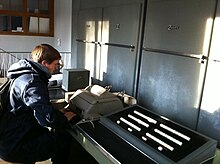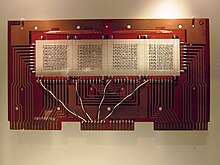Z22
The Z22 computer or short Z22 was constructed in 1955 by the physicist Lorenz Hanewinkel and the Zuse KG -built computer . It was the first tube computer from West Germany . The comparable D1 was developed in the GDR from 1950 to 1956. As one of the first mass-produced computers in the world, the Z22 enabled German colleges, universities and other scientific institutes to process electronic data for the first time after the Second World War .
history
After the Z1 , Z2 , Z3 , Z4 , Z5 and Z11 models, the Z22 was the seventh computer model developed under Konrad Zuse . Like its predecessors from the Z4 onwards, the Z22 machine has already been sold commercially; a Z4 rented to Switzerland in 1950 was probably the first computer ever to be commercially traded.
The development of the Z22 was completed around 1957, the first of a total of 55 copies were sold to the TU Berlin and Aachen from 1958 . One of the first customers was the Zeiss company , which from then on owned a computer for their optical calculations. Theodor Fromme , Scientific Director at Zuse and a former employee at Zeiss, played a key role in drawing up the circuit diagrams for this calculating machine.
Diebold computer statistics show a total of 48 copies of the Z22 for July 1, 1971.
Technical specifications
In the standard version, the Z22 was equipped as follows:
- Register set consisting of 14 words of core memory of 38 bits each
- 38 kbyte drum memory (8,192 words at 38 bits)
- Paper tape reader / punch as mass storage
- 380 V, 16 A three-phase supply
- 600 electron tubes , switched as flip-flops .
- Electric cooling system that needs its own water connection
The clock frequency of the Z22 was 3 kHz, which corresponded exactly to the speed of the drum store. The input of data could take place via the punched tape reader as well as via a direct input of data on the drum storage unit and via buttons for direct programming of the core storage.
The relatively fast output of data could be done using a paper tape punch, a relatively fast reading in using an opto-electrical paper tape reader. Some data could also be displayed via the glow lamps built into the control panel , which represented important register contents.
Siemens T100 teleprinters with an attached 5-channel punched tape reader and punch were used as a combined input / output device. Four "peripheral devices" were thus available in one machine: keyboard input, punched tape input, paper recorder output and punched tape output. Their working speed was ten characters / second and was significantly slower than the special mono devices punch card punch and reader.
programming
The Z22 was developed with the aim of being easier to program than previous generation computers. It was programmed in machine code; each instruction was 38 bits wide and divided into five fields of fixed length:
- The first 2 bits were always "10"
- The next 5 bits contained a conditional operator symbol
- The next 13 bits contained an operation symbol
- The next 5 bits contained a core memory address
- The last 13 bits contained a drum memory address
To further simplify programming, an assembler-like language called “ Freiburg Code ” was developed. The gate switch bits were essential elements of this code. Each of these bits switched a gate from or to the (drum) memory cell addressed in the address section of the command from or to the addressed register via a switching cascade. Each of the bits in the command part addressed a gate - one of which existed for evaluating a condition:
- Value = 0,
- Value <0,
- Value> 0,
- Value≤0,
- Value≥0.
The operating gates led to a circuit
- LLR for a shift by 1 step to the left - more precisely, there was only one gate for 2 steps to the left - in the PP program
- R for a step to the right,
- N for zero setting,
- A for adding,
- S for subtract, etc.
The load command common in later assembler had the coding in the Freiburg code:
- NA zeroing + adding
- RNA meant loading halved
- LLNA requested that the doubled value be loaded.
This language was developed with the aim of simplifying the implementation of mathematical algorithms; this goal was achieved in practice.
Z22 today
The Karlsruhe University of Applied Sciences owns a restored and fully functional copy with the serial number 13, which was built in 1958. This machine was given to the Center for Art and Media (ZKM) as a permanent loan on March 9, 2005. It was taken apart by the two Zuse experts Hans Baumann and Helmut Kammerer and rebuilt at the ZKM. The Z22 / 13 is the oldest still functioning, true to the original tube computer in the world and is a listed building. Another fully functional Z22R is on the campus of the Suderburg University of Applied Sciences (part of the Ostfalia University of Applied Sciences ).
The Konrad-Zuse-Computer Museum in Hoyerswerda (Saxony) owns two copies of the Z22, although they are no longer working. Another example built for Prof. Hubert Cremer at the RWTH Aachen was in the former Computer Museum Aachen . This is also no longer functional.
In the head building of the University of Linz , in front of the lecture halls HS9 & 10, there is also a no longer functioning copy. Another, no longer functional Z22 is in the Technikmuseum Berlin .
In the computer museum of the Kiel University of Applied Sciences there is a system that is no longer operational and can be viewed during the normal opening hours of the museum.
A Z22 is located in the IT department of the Deutsches Museum in Munich .
A Z22R is also in the Museum Wortreich in Bad Hersfeld .
A restored, working Z23 from 1962 belongs to the Erlangen ISER computer science collection of the Friedrich-Alexander University Erlangen-Nuremberg . It is probably the only working Z23 worldwide.
Other Zuse calculators
literature
- Lorenz Hanewinkel: Computer Revolution . My way with Konrad Zuse and Heinz Nixdorf , Verlag Druckerei Kleine, Paderborn 2010, ISBN 3-9807412-7-3
- Lorenz Hanewinkel: Construction of the Zuse Z22 calculating machine , Horst Zuse (Ed.), Berlin 2009
- Clemens Kieser: “I'm too lazy to do arithmetic” - Konrad Zuse's computer Z22 in the Center for Art and Media Karlsruhe. (PDF; 3.2 MB) In: Preservation of monuments in Baden-Württemberg. 4/34/2005, Esslingen am Neckar, ISSN 0342-0027 , pp. 180-184.
- Wolfgang Stieler: Tube logic and drum storage. A Zuse Z22 is still running in Karlsruhe . In: c't . 20/2002. Pp. 100-104, ISSN 0724-8679
- Konrad Zuse: The computer - my life's work , 3rd edition. Springer, Berlin 1993, ISBN 3-540-56292-3
Web links
- Construction of the Z22
- The Zuse Z22 / 13 of the FH Karlsruhe
- Handover of the only still running Z22
- Karlsruhe: City history - Computer Zuse Z22 in the University of Applied Sciences Karlsruhe
- Zuse Z22 in the Center for Art and Media History Karlsruhe
- The Life and Work of Konrad Zuse: The Z22 Computer ( Memento from March 7, 2001 in the Internet Archive )
- Konrad Zuse Computer Museum
- Zuse-Z23-Simulator u. a.
- Online simulation of the Zuse Z22R / 45 ; Documentation of all commands; internal representation of commands, numbers and text; Basic program from 1961; Punched tape coding; Functional program examples and further information.
- Zuse Z22 emulator in JavaScript : runs directly in the web browser and contains examples from the Z22 programming instructions from Zuse KG (trigonometric functions, Runge-Kutta method for solving differential equations, matrix multiplication, etc.)
Individual evidence
- ^ ZKM : The Algorithmic Revolution: Konrad Zuse. ( Memento of the original from February 20, 2007 in the Internet Archive ) Info: The archive link was inserted automatically and has not yet been checked. Please check the original and archive link according to the instructions and then remove this notice.
- ^ Kurt Badertscher, Josef Gubelmann, Johannes Scheuring: Business Informatics Basics: Designing information and communication systems. Basics with numerous illustrations, examples, repetition questions and answers. Compendio Bildungsmedien Verlag, 2006, ISBN 978-3-7155-9271-8 , p. 14.
- ^ Zuse Z22R on the Suderburg campus





